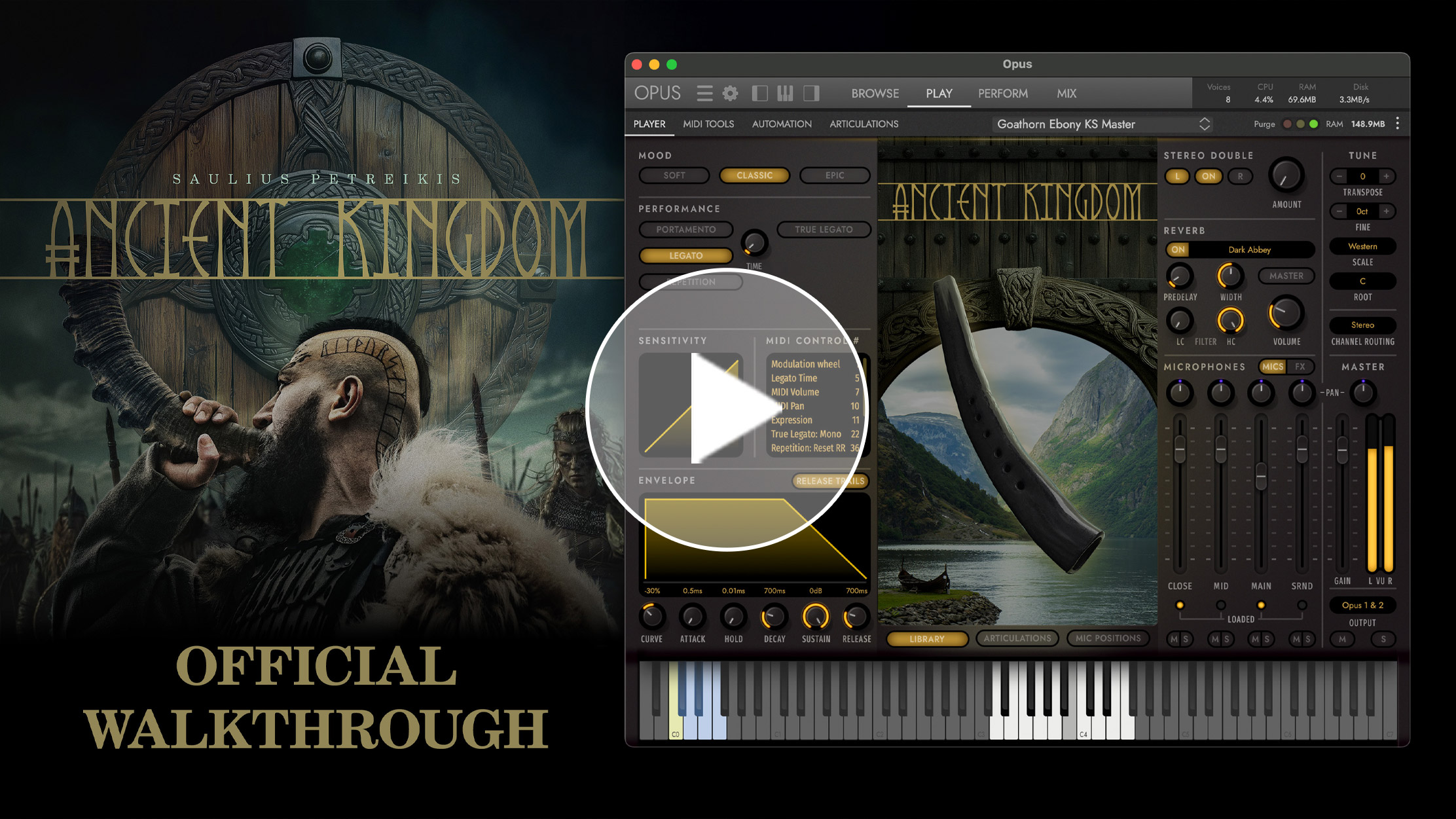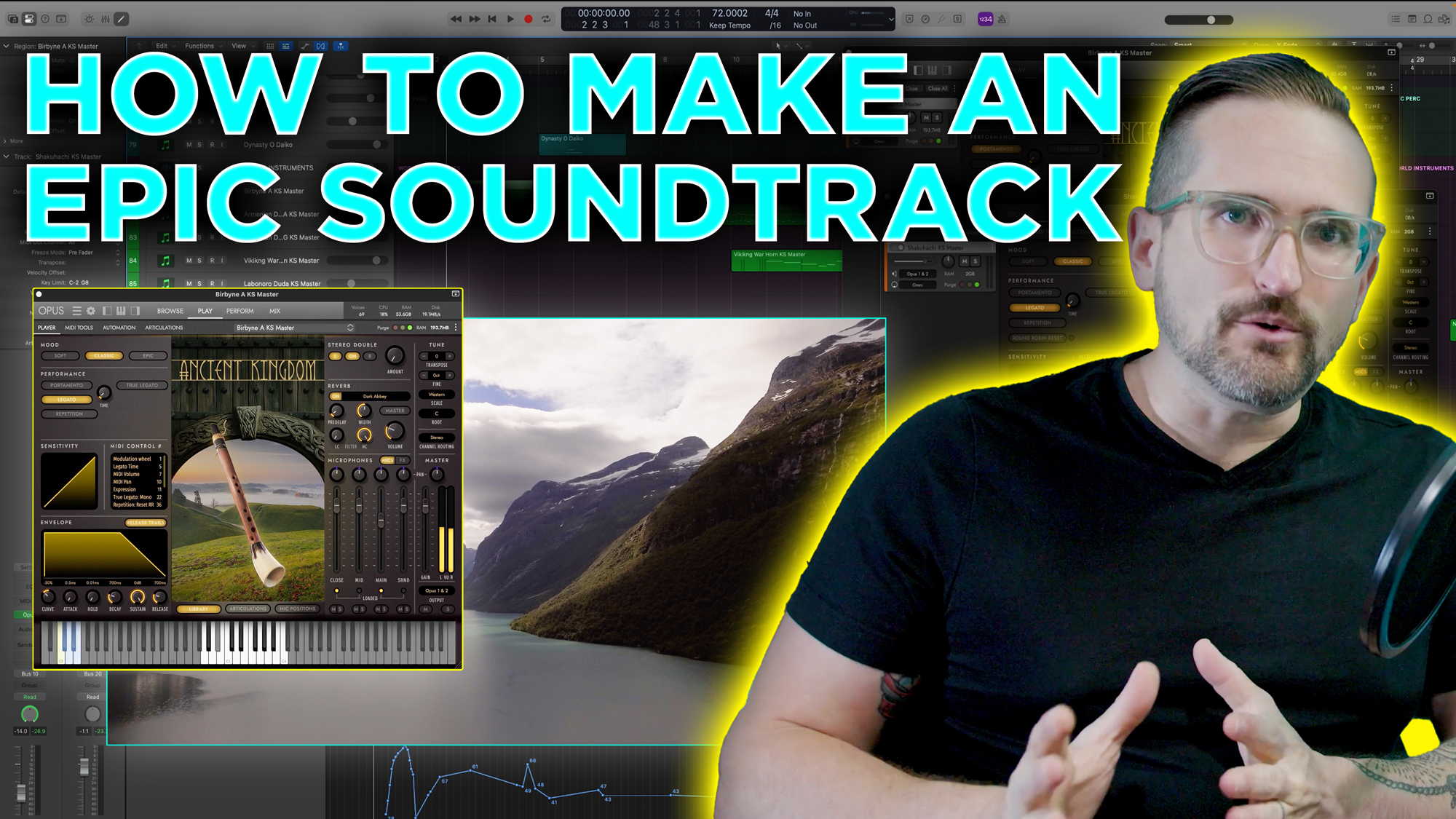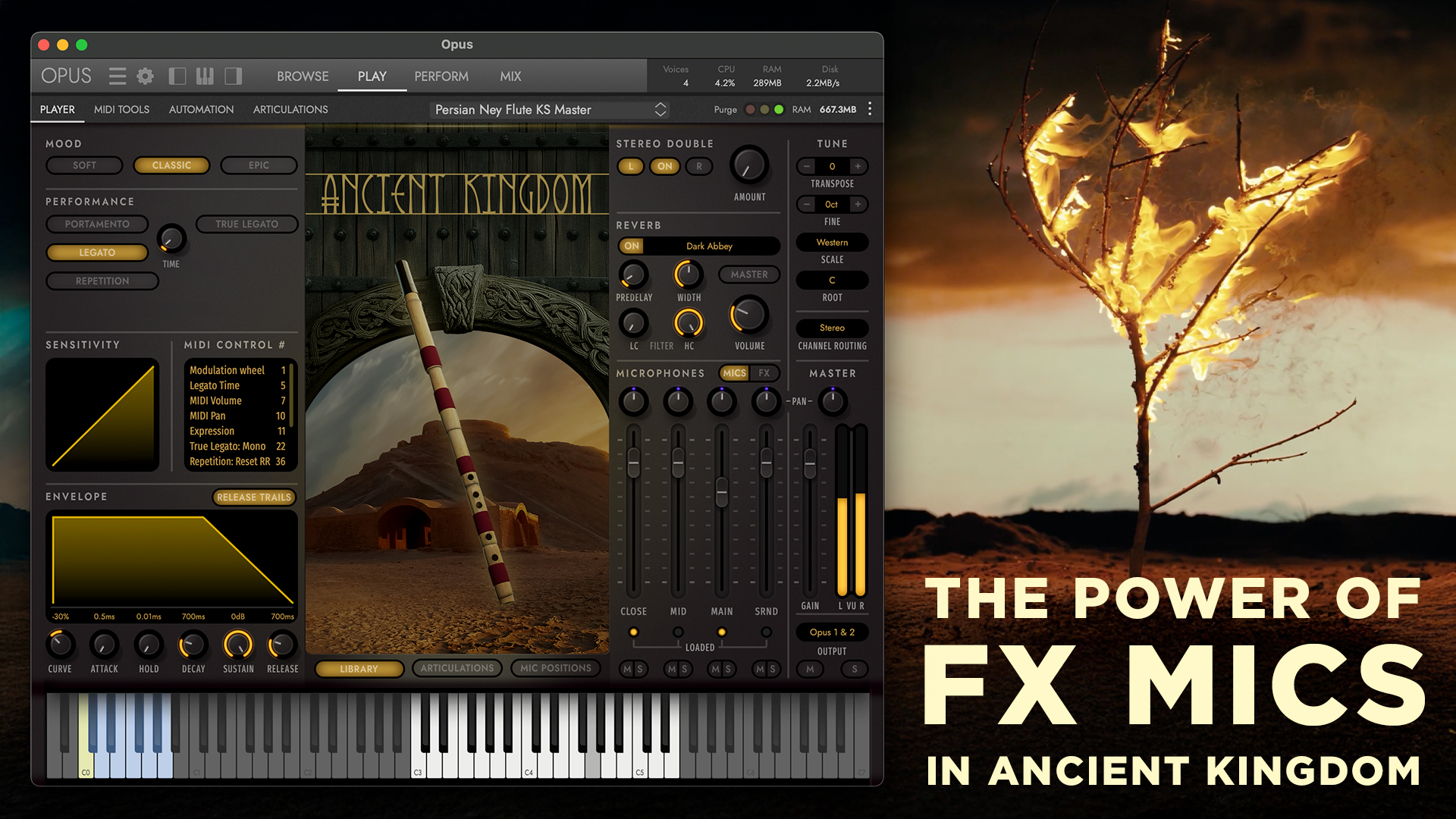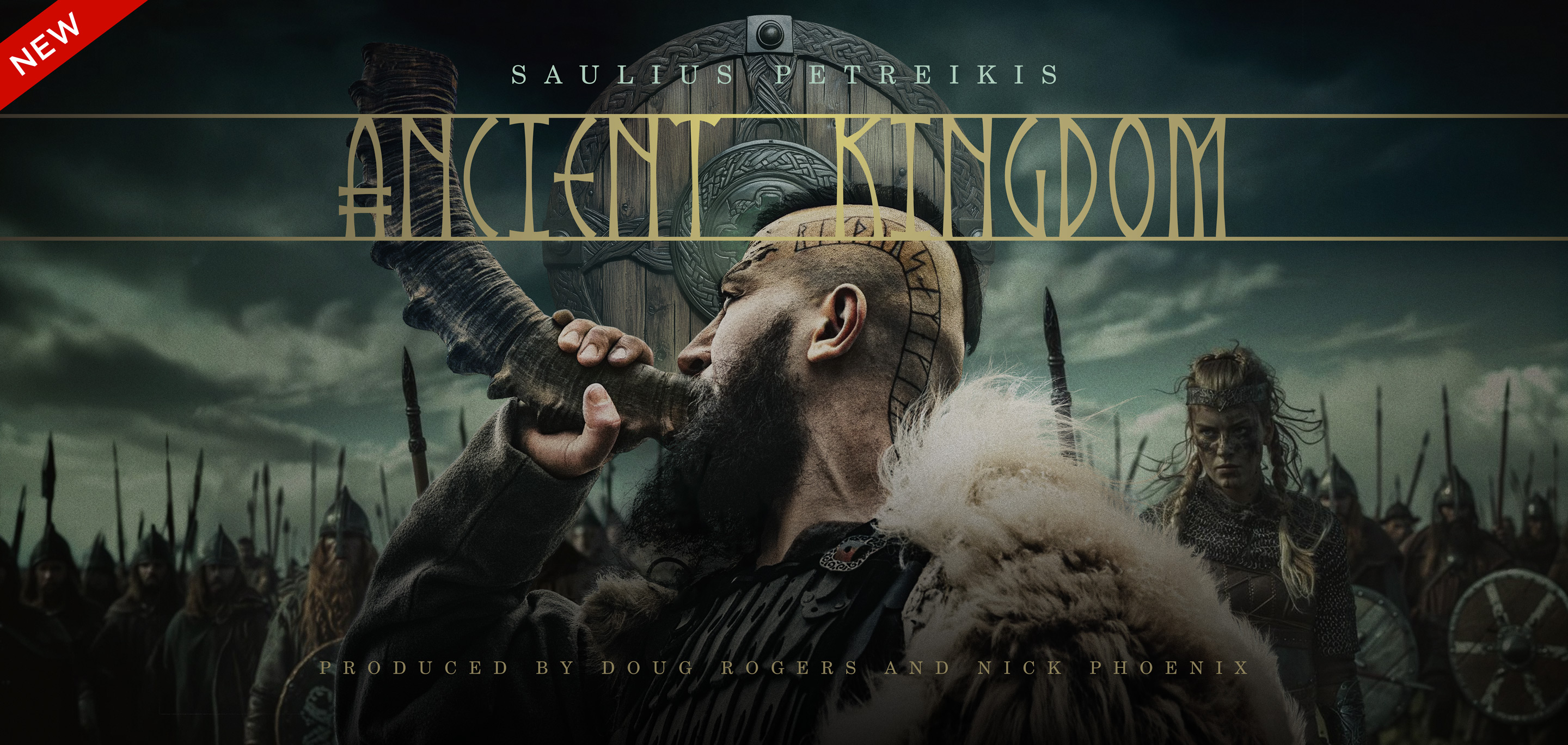
ANCIENT KINGDOM
Ancient Sounds,
Modern Mastery
Unleash the sounds of forgotten realms with Ancient Kingdom, a brand-new virtual instrument collection produced by Doug Rogers and Nick Phoenix and featuring world-renowned recording artist Saulius Petreikis playing his rare selection of wind instruments from around the world. With four groundbreaking effects signal paths in addition to pristine multi-mic recordings, step into the unknown and let Ancient Kingdom transport your music into a dimension where the past meets the future and the spirits of lost worlds come to life with every note.
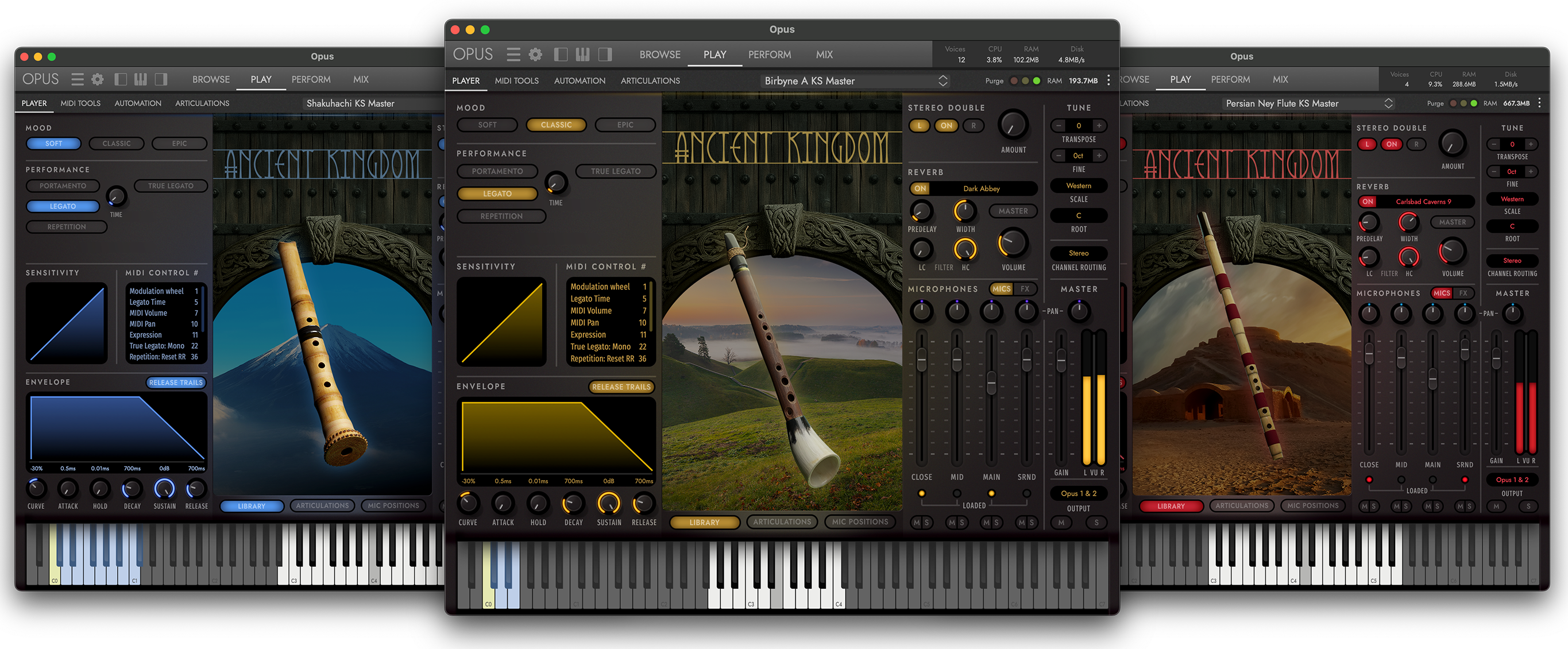
Check Out These
Multi-Track Demos
From the Echoes of Antiquity to the Edges of the Unknown
Ancient Kingdom’s intuitive user interface invites you to explore the primal essence of rare wind instruments while forging into transcendent sonic realms. Anchored by a vivid Center Display with striking 3D instrument models and immersive landscapes representing their origins, its interface offers effortless command over instrument libraries, articulations, multi-mic configurations, and more. The Left Panel empowers you to shape the sound with versatile Mood presets, powerful performance scripts, and precise MIDI controls, while the Right Panel transforms ancient tones into otherworldly textures through innovative FX mixes, convolution reverbs, and flexible channel routing.
Mood Section
Instantly change an instrument’s settings between 3 different presets to better fit the needs of your music composition. Use the default ‘Classic’ Mood for a balanced sound that blends the Close and Main microphone positions with a Southern California Hall reverb preset. Choose the ‘Epic’ Mood for a dramatic sound that blends the Close and Surround microphones with the Live Cathedral reverb preset. Or choose the ‘Soft’ Mood for an intimate sound that blends the Mid and Surround microphones with the Hollywood Hall reverb preset.
Stereo Double
Widen the stereo spread by adding in a source from either the right or left side of the stereo image. Please note: this requires that ‘Stereo’ is set in the Channel Routing section, which is the default setting.
Tune
Control all things global tuning by adjusting controls for transpose (coarse) and fine tuning, and select between an array of microtuning scales. Adjust coarse tuning in semitone (half-step) increments using the ‘Transpose’ buttons, adjust fine tuning in cents using the ‘Fine’ buttons, and select microtuning by selecting an option in the ‘Scale’ and ‘Root’ drop-down menus.
Performance Section
Change the playback behavior of an instrument in various ways by using the powerful scripts. Many instruments in Ancient Kingdom are saved with scripts enabled by default, such as the Legato instruments that use the ‘True Legato’ script required to play back all the individual legato intervals sampled between each note (up to an octave in either direction). The ‘Legato’ and ‘Portamento’ scripts are also used in many instruments in Ancient Kingdom to emulate said techniques by forcing monophonic behavior and adjusting note timing to produce smooth melodic lines, which can be adjusted by using the ‘Time’ knob.
Reverb
Add dimension and depth with our celebrated convolution reverb effect that uses impulse responses (IRs) captured from real spaces and convolves it with the input signal to simulate the sound of playing an instrument in the selected space. Use the ‘Master’ button to save resources by applying reverb to all instruments within a given instance of Opus.
Channel Routing
Change how an instrument is output by selecting different ‘Channel Routing’ options that include Stereo, Mono, Mono from Left, Mono from Right, or Swap Left and Right.
Sensitivity
Change the Sensitivity’s response curve from its default linear setting to make the MIDI Velocity more or less sensitive to reach maximum velocity between a scale of 1 to 127 (MIDI Standard). Create a convex curve to make MIDI Velocity input more sensitive (requires less force), or a concave curve to make it less sensitive (requires more force).
MIDI Control
View a list of all the available MIDI Control Changes (CCs) available for the selected instrument in order to control them in real-time using your MIDI controller’s knobs and sliders.
Microphones
Use the controls in this section to change the volume, panning, on/off state, and mute/solo states of the 8 Microphone and FX Mixes included in Ancient Kingdom. Use the ‘Mics’ and ‘FX’ buttons in the top-right corner of this section to toggle between the 4 Microphone mixes (Close, Mid, Main, and Surround), and the 4 FX mixes (1-4).
Master Channel
Control an instrument’s final audio output by adjusting its volume, pan and mute/solo controls. Change the output of an instrument to one of up to 8 stereo pairs in stand-alone mode, and up to 16 stereo pairs in plug-in mode. Please note: change the ‘Output Configuration’ in the Settings menu under the Audio Engine tab to adjust the number of available outputs.
Envelope
Adjust an instrument’s global volume over time by changing the controls of the 5-stage envelope (Attack, Hold, Decay, Sustain, Release), with an additional Curve control that changes the Attack stage from its default linear setting to produce a convex or concave curve.
Library
Features artwork for the selected instrument, which includes a 3D model of the instrument itself against a background landscape representing where the instrument originates from.
Articulations
Appears when an instrument containing multiple articulations is loaded, such as a Keyswitch (KS) instrument that uses notes outside the sampled range to switch between articulations, or a MOD instrument that uses the Mod Wheel (CC#1) to cycle through articulations.
Mic Positions
Mic Positions depicts the various microphone positions used to record an instrument. The instrument position is represented as a node from which sound waves emanate. Microphone mixes are labeled with a single letter abbreviation, light up when activated, and are positioned relative to the sound source. An array of FX mixes are aligned along the bottom to activate four groundbreaking signal paths that employ various innovative techniques using amplifiers, vibration enhancers, metallic surfaces, distortion amplifiers, megaphones, tubes, and rotating speakers to create a dynamic and immersive auditory experience.
Keyswitch Range
The range of notes used to switch between articulations in Keyswitch (KS) instruments are highlighted in blue on the virtual keyboard. The currently selected keyswitch is colored yellow.
Instrument Range
The playable range of an instrument is shown by highlighting the keys in white on the virtual keyboard. Keys without samples mapped to them appear grayed out.
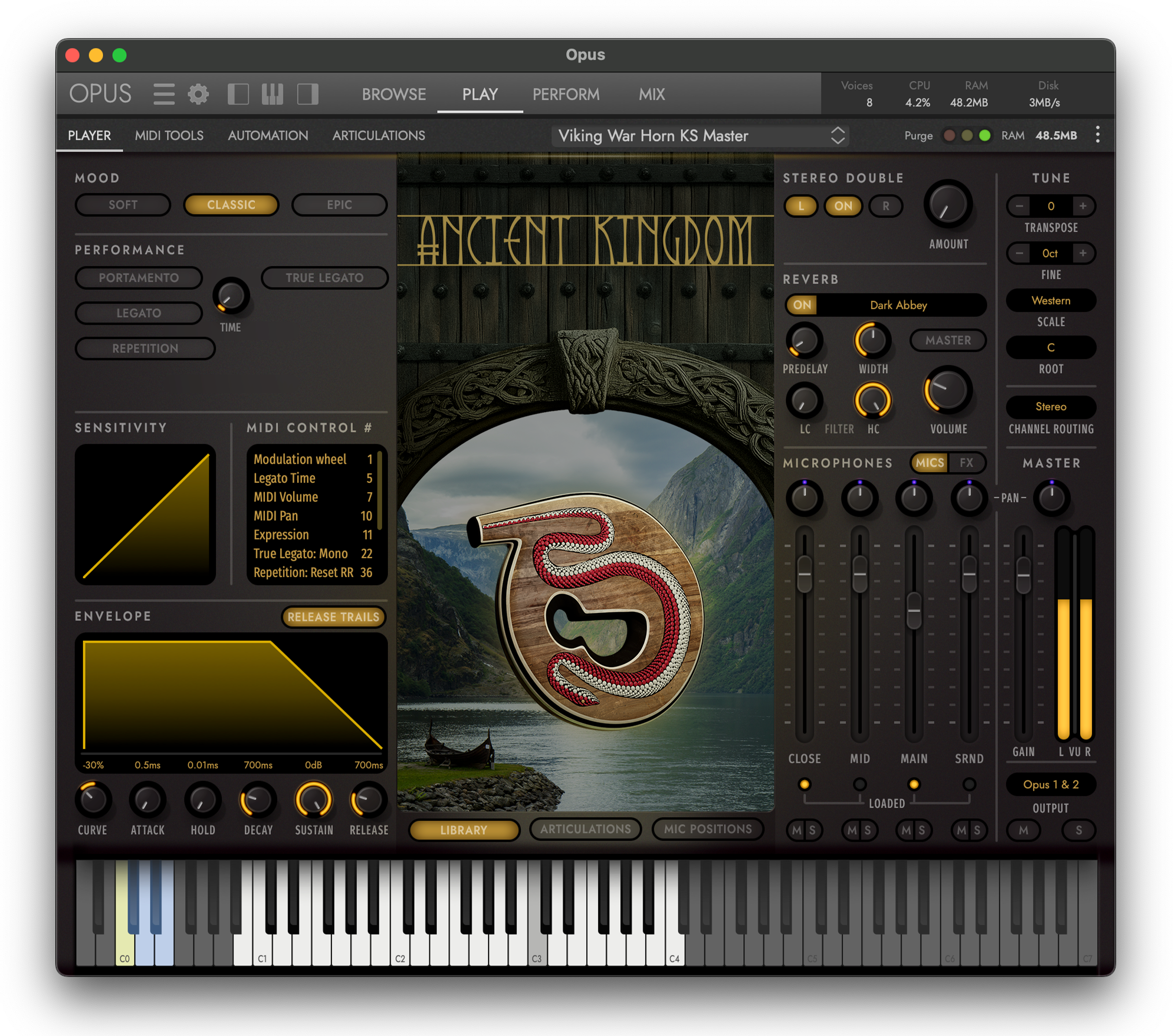
Unique Recording Techniques
In addition to the pristine surround sound recordings, this collection introduces four groundbreaking signal paths. These paths employ various innovative techniques, utilizing amplifiers, vibration enhancers, metallic surfaces, distortion amplifiers, megaphones, tubes, and rotating speakers to create a dynamic and immersive auditory experience. These signal paths take the sounds into an other-worldly dimension like you’ve never heard before. The alternate signal paths enhance the presence and capture the listener’s attention by emphasizing the instruments' attack characteristics, offering a bold and vivid listening experience. Whether used in traditional compositions or experimental soundscapes, Ancient Kingdom provides a rich palette of sounds inspired by the historical essence of these magnificent instruments.
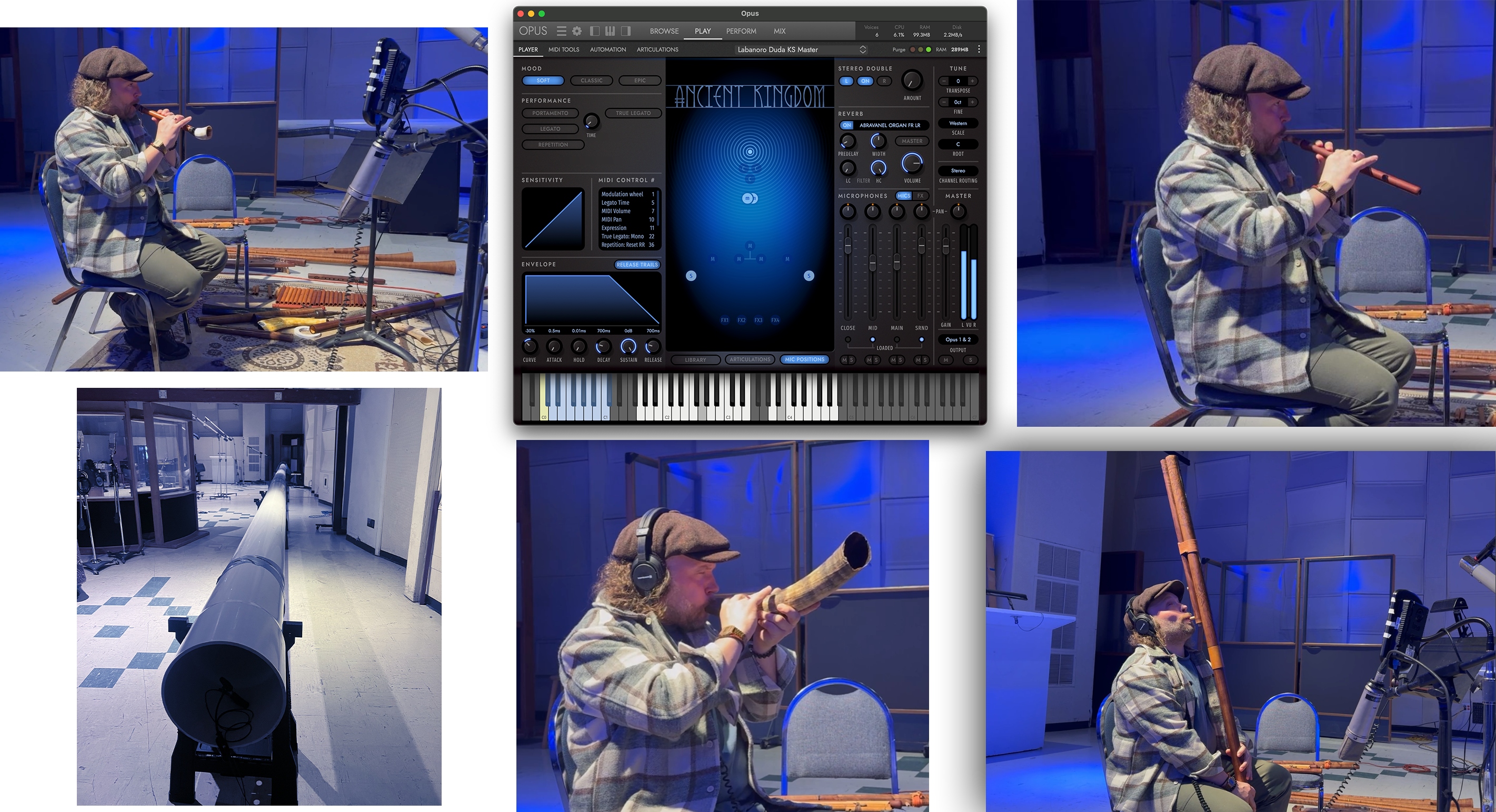
About the Team
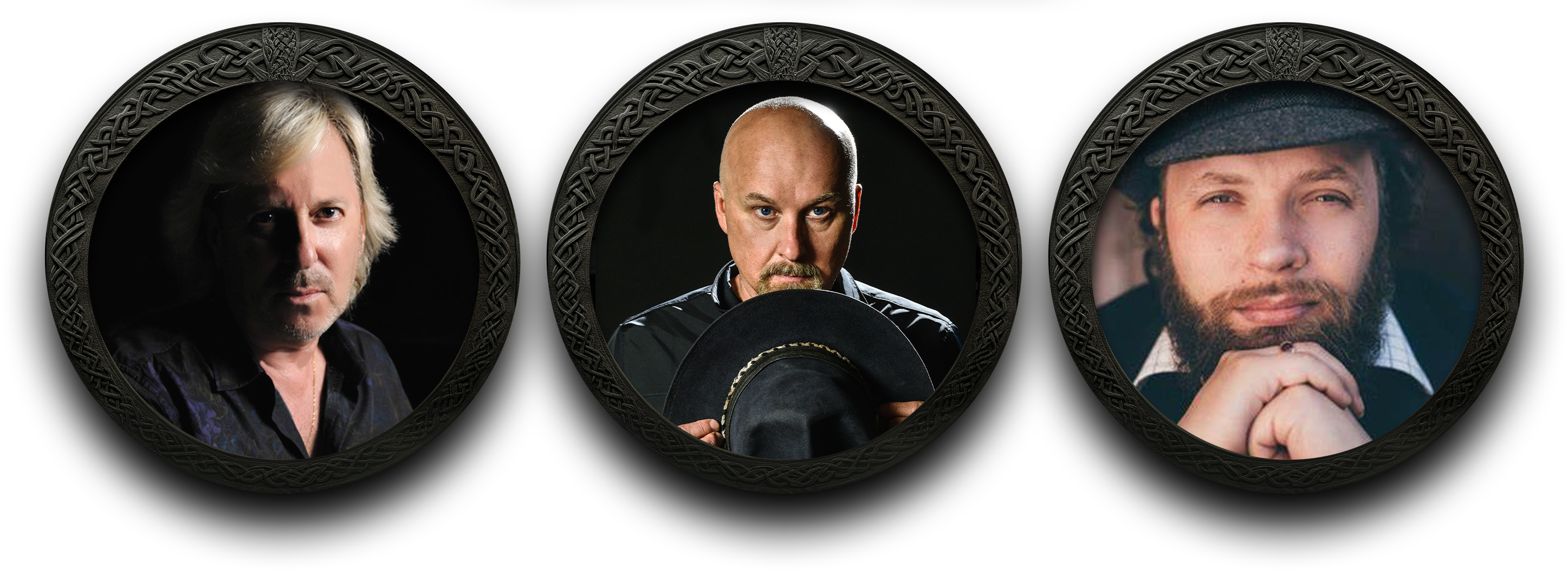
Producer Doug Rogers:
Doug Rogers is a highly esteemed producer and the visionary behind EastWest, one of the most influential companies in the world of virtual instruments and sound libraries, and recipient of three NAMM TEC Awards in the past five years for “Best Musical Instrument Software”. Rogers’ contributions to the music industry through EastWest have had a profound impact on music production. His dedication to quality and innovation has provided musicians with tools that have changed the way music is created and produced. His work with EastWest has empowered countless musicians to bring their creative visions to life with unmatched sound quality and realism.
Producer Nick Phoenix:
Nick Phoenix, a London-born, American-raised composer and sonic visionary, has redefined music production through his groundbreaking work with EastWest Sounds and as co-founder of Two Steps From Hell. For over two decades, he’s crafted iconic virtual instruments like Hollywood Orchestra, Symphonic Orchestra, and Stormdrum, earning over 100 awards for innovations like choirs that sing typed words and custom convolution reverbs. His epic music, streamed by millions, has scored 1,000+ film trailers and helped spark a global genre. Now, Phoenix channels his creative fire into Ancient Kingdom, a virtual instrument collection co-produced with Doug Rogers. Featuring Saulius Petreikis’ rare wind instruments and four revolutionary effects paths, Phoenix blends ancient echoes with futuristic flair for a truly immersive sonic journey.
Performer Saulius Petreikis:
Saulius Petreikis is a Lithuanian composer and wind instrument virtuoso, known for blending ancient Samogitian-Baltic harmonies with global World Music traditions. Over the past 20 years, he has released 11 original albums, contributed to more than 30 others, and performed in major international projects such as Two Steps From Hell, Hans Zimmer: A New Dimension, and The World of Hans Zimmer – An Immersive Symphony. Mastering over 50 unique wind instruments, Saulius electrifies audiences with spirit-lifting improvisations and genre-defying performances that resonate worldwide. He also composes for film, theater, and video games, collaborating with artists across disciplines to create powerful, boundary-breaking works, leaving a profound mark on the global music scene.
What's Included?
Ancient Kingdom features 26 instrument categories, each with an array of highly detailed instrument articulations and combinations across a range of instrument type sub-categories that includes Long, Short, Effects, Legato, and Keyswitch.
Armenian Duduk (Available in A, C, and G)
The Armenian duduk is an ancient double-reed woodwind instrument known for its warm, soulful, and deeply expressive sound with haunting depth, ideal for crafting emotive melodies in cinematic or world music scores. Historically, the duduk is a powerful symbol of Armenian cultural identity and the cornerstone of the nation’s folk music, used in funerals, weddings, and spiritual ceremonies for centuries. Evoke Armenia’s ancient heart in your compositions with the duduk’s mournful, evocative voice.
Bansuri
The bansuri is a traditional Indian bamboo flute, known for its warm, airy timbre, producing a serene sound ideal for melodic or meditative layers in both solo and ensemble settings. In India, the bansuri has been used since ancient times in devotional ceremonies and raga performances, symbolizing a spiritual connection to Hindu mythology, particularly Lord Krishna’s divine flute. Infuse your music with India’s spiritual essence through the bansuri’s serene, soulful sound.
Birbyne(Available in A and Db)
The birbyne is a traditional Lithuanian woodwind instrument, typically made of wood, with a pure, nasal timbre producing a bright, folk-like sound, ideal for lively or rustic themes in Baltic or historical compositions. In Lithuania, the birbyne is a cherished voice of rural festivals, where its spirited notes have rallied communities for centuries, preserving folk heritage through vibrant melodies. Capture the vibrant pulse of Baltic festivals in your music with the birbyne’s lively tones.
Dambrelis
The dambrelis is a traditional Lithuanian jaw harp made from metal or bamboo, which produces sound by plucking a flexible tongue while holding the frame against the teeth or lips. The player's mouth acts as a resonator, shaping the tone and pitch, creating a distinctive twanging, rhythmic sound. It has been used in Lithuanian folk music for centuries, often for solo performance or accompaniment. Historically used by Baltic farmers and herders for entertainment and rituals, it represents simplicity and connection to nature, often played in intimate or ceremonial settings. Infuse your tracks with an earthy Baltic touch with the dambrelis’ twanging rhythmic pulse.
Double
Shepherd Flute
The double shepherd flute is a traditional Slavic double flute, made from wood and consisting of two parallel pipes, creating a rich, dual-layered sound with a warm, harmonious timbre and a bright upper range well-suited for pastoral or emotive themes. Its cultural significance lies in its role in community storytelling and celebrations, preserving Balkan musical identity through oral traditions. Linked to rural shepherding, it was played during long days in the fields, carrying the pulse of village life. Evoke the Balkan highlands in your compositions with the flute’s soulful, harmonious tones.
Flugelhorn
The flugelhorn is a brass instrument with origins in Germany, known for its smooth, lyrical sound and rich timbre, bridging the gap between the trumpet and French horn. Its warm, mellow sound makes it ideal for majestic yet intimate themes. Developed in 19th-century Germany for military and marching bands, it later became prominent in classical and festive music, symbolizing German precision and innovation in brass design with its noble, uplifting qualities. Evoke the grandeur of Germany’s festive legacy with the flugelhorn’s velvety, majestic tones.
Fujara(Available in High and Large)
The fujara is a large Slovakian overtone flute made from wood, producing a deep, resonant timbre with natural overtones, delivering a bold, earthy sound perfect for dramatic or meditative melodies in folk or cinematic scores. Recognized as intangible cultural heritage, the fujara symbolizes Slovak folk traditions tied to pastoral life, played by shepherds in the mountains to communicate or reflect, evoking the rugged beauty of Slovak landscapes. Infuse your compositions with Slovak heritage using the fujara’s deep, earthy voice.
Goat Horn Amber
The goathorn is a traditional Lithuanian wind instrument featuring a simple design with a few finger holes. It is made from a real goat horn, sometimes adorned with amber, and produces a raw, earthy timbre ideal for adding intensity to battle themes or creating visceral ceremonial cues. In Scandinavian and Baltic cultures, goathorns were used in rituals and warfare to signal gatherings or battles, rooted in Norse traditions and symbolizing strength and ancestral connection. Evoke the Scandinavian warrior spirit in your scores with the goathorn’s fierce, primal sound.
Goat Horn Ebony
The ebony goathorn is a modern variation of the traditional goathorn, crafted from dense, dark ebony wood instead of animal horn. While retaining the classic shape and playing technique, this version offers a richer, more refined tone with improved durability and resonance. It typically features a few finger holes and is used in folk and contemporary interpretations of Baltic music. Blending traditional craftsmanship with modern materials to give a fresh voice to an ancient sound, the ebony goathorn infuses your music with Viking spirit and contemporary craft through its rich, woody tone.
Hulusi(Available in High and Low)
The hulusi is a traditional Chinese free-reed wind instrument featuring a gourd wind chamber and bamboo pipes, including one main melody pipe and often one or two drone pipes. It produces a smooth, mellow, and haunting sound reminiscent of a clarinet, making it well-suited for lyrical melodies or atmospheric layers in world or cinematic music. Originating from the Dai and other ethnic minorities in Yunnan province, the hulusi was historically played at festivals and courtship rituals, embodying community and social harmony. Evoke China’s ancient revels in your music with the hulusi’s silken, lyrical tones.
Irish Whistle(Available in Regular and High)
The Irish whistle is a simple six-holed woodwind instrument that produces a bright, clear tone, capable of expressive ornamentation and fast, intricate melodies by a skilled player. In Ireland, it is a cornerstone of traditional folk music, played at pubs, dances, and festivals since the 19th century. It represents cultural identity through storytelling, passing down tales of strength and resilience. Evoke Ireland’s defiant Celtic spirit with the whistle’s bright, expressive melodies.
Labanoro Duda
The Labanoro duda is a unique and rare Lithuanian bagpipe traditionally associated with the Labanoras region. It features a single drone with a melody pipe (chanter), typically made from wood and animal hide, which produces a robust, droning timbre with driving rhythmic energy. Though it nearly disappeared, recent efforts have revived its craftsmanship and performance, making it a symbol of Lithuanian musical heritage. It continues to celebrate its cultural significance in folk dances, rural festivals, and weddings, with roots tracing back to medieval traditions. Evoke Baltic celebrations in your compositions with the Labanoro duda’s earthy, rhythmic pulse.
Native American
Cedar Flute(Available in Flute and Piccolo)
The Native American flute is a traditional wind instrument used by Indigenous peoples of North America, known for its breathy, warm timbre and haunting, deeply emotive sound. Typically made from wood or bamboo, it has two chambers and is played as an end-blown flute, with a block (or "bird") directing air over a sound hole. Historically, it was integral to courtship ceremonies and storytelling, with each tribe crafting unique designs to reflect spiritual connection, healing, and communal values tied to Indigenous traditions. Evoke ancestral spirits with the flute’s breathy, heartfelt melodies.
Persian Ney Flute
The Persian ney is an ancient end-blown flute made from a hollow reed with six finger holes, producing a breathy, intimate timbre and poignant, emotional sound ideal as a solo melodic voice. It is central to Persian classical music and Sufi mysticism, played for centuries in spiritual and poetic settings, its expressions of longing and divine connection symbolizing cultural significance. Infuse your scores with Persian mysticism using the ney’s emotive, soulful voice.
Shakuhachi
The shakuhachi is a traditional Japanese end-blown bamboo flute with five finger holes that creates a rich, breathy timbre, capable of producing a wide range of expressive sounds through subtle breath control and finger techniques. Originally used by Zen Buddhist monks for meditation since the 8th century, the shakuhachi is now a key instrument in Japanese classical, folk, and contemporary music, embodying the spiritual discipline and tranquility central to Japanese Zen tradition. Evoke Japan’s meditative serenity with the shakuhachi’s raw, soulful call.
Skuduciai Pipes
Skuduciai pipes are traditional Lithuanian panpipe-like instruments made from wood or reed, producing a delicate, airy quality with a woody timbre that adds subtle, organic textures. They are an important part of Lithuania’s cultural heritage, played in folk festival ensembles practicing ancient polyphonic traditions. Their origins in rural villages tie them to communal harmony and nature. Evoke Lithuania’s ancient rural spirit in your scores with the pipes’ gentle, airy tones.
Viking Lur
The Viking lur is an ancient Scandinavian and Baltic wind instrument made from bronze or wood and shaped in a long, curved form resembling an animal horn. With no finger holes, it plays natural harmonics that gives it a bold, brassy timbre with a haunting, resonant tone ideal for epic fanfares and battle themes. Dating back to the Bronze Age, lurs are iconic symbols of early Nordic musical heritage, used in ancient traditions to signal important events or rituals and unite communities in ceremony. Evoke Viking glory in your compositions with the lur’s commanding, regal tones.
Viking Voices
The vocal traditions of the Norse people during the Viking Age were often tied to storytelling, rituals, and communal gatherings. Viking voices produce a raw, guttural timbre with primal expressions, taking the form of chanting as part of rituals, rhythmic recitation, mythic storytelling, and melodic forms rooted in oral tradition. They form a vital part of Norse cultural and spiritual life, evoking ancestral spirits and collective strength. Evoke ancestral hymns in your compositions with the raw, primal depth of Viking voices.
Viking War Horn
The Viking war horn is a traditional Nordic signaling instrument, typically carved from animal horn or wood, which produces a deep, commanding sound whose power belies its simple design. During the Viking Age, war horns—symbols of courage and calls to action—were used to communicate across great distances, rallying warriors, signaling attacks, and initiating gatherings and sacred rituals. Evoke the Viking marauder’s spirit in your compositions with the war horn’s deep, resonant blast.
What Will You Create?
This isn’t just another virtual instrument collection—it’s a portal to uncharted sonic realms for composers and producers seeking to transcend the ordinary. Ancient Kingdom, crafted by Doug Rogers and Nick Phoenix, harnesses the haunting, rare wind instruments of Saulius Petreikis, paired with pristine multi-mic recordings and four innovative effects signal paths. These tools defy convention, blending ancient timbres with futuristic textures to ignite your creative spark. If you’re ready to weave the spirits of lost worlds into your music, this extraordinary library is your key to crafting bold, timeless soundscapes.
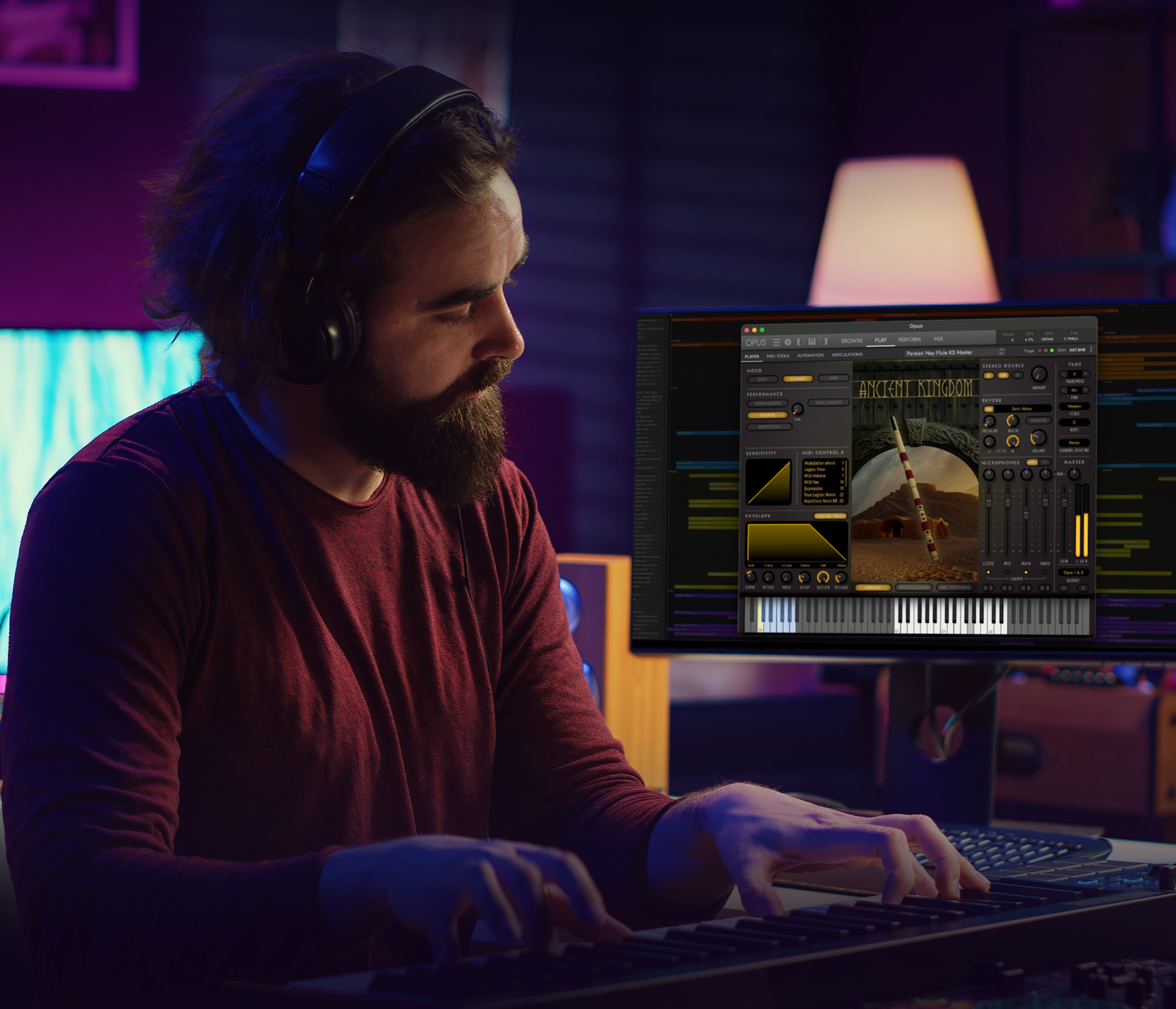
MANUAL
SYSTEM
REQUIREMENTS
Below are the minimum and recommended hardware and software specifications for using Opus 1.5.6 (required for Ancient Kingdom) on Windows and MacOS systems.
|
MINIMUM SYSTEM
|
RECOMMENDED SYSTEM
|
The chart below outlines the MacOS and Windows 64-bit operating systems and sequencers that are officially supported and fully tested with the latest version of Opus. Please note that while most Sequencers / DAWs are VST 2, VST 3, AU and AAX plug-in format compatible, only those listed in the chart below are officially supported.
| Product | Version | MacOS (10.15+) | Windows 10 |
|---|---|---|---|
| EW Opus Stand-Alone | 1.5.0+ | YES | YES |
| Ableton Live | 10.1.2+ | YES | YES |
| Apple Logic Pro | 10.7.9+ | YES | - |
| Apple Garageband | 10.4.9+ | YES | - |
| Avid Pro Tools | 2019.12+ | YES | YES |
| Bitwig Studio | 3.1.3+ | YES | YES |
| Cockos Reaper | 6.0+ | YES | YES |
| Image-Line FL Studio | 20.6+ | YES | YES |
| Motu Digital Performer | 10.11+ | YES | YES |
| Steinberg Cubase(1) | 10.0.5+ | YES | YES |
| Steinberg Nuendo(1) | 10.2+ | YES | YES |
| Presonus Studio One | 4.5.4+ | YES | YES |
| VSL Vienna Ensemble Pro | 7.0+ | YES | YES |
| Notation Software(2) | Version | ||
|---|---|---|---|
| Avid Sibelius | 2019.9+ | YES | YES |
| MakeMusic Finale | 26.1+ | YES | YES |
| Steinberg Dorico | 3.0.10+ | YES | YES |
- (1) VST3 usage is recommended
- (2) Sibelius / Finale / Dorico notation programs work with Opus, but do not support the full feature set of some Opus/Play Libraries, such as those that use WordBuilder. Please contact support for details.
Ancient Kingdom
Do You Want to Buy This Product or Get All Products With ComposerCloud+?
- Includes perpetual license to Ancient Kingdom
- Includes EastWest Instruments
- Includes EastWest Opus Player, 46 Mixer Effects and MIDI Tools
$239.88/year $99/year
- Includes Ancient Kingdom and all 80+ EastWest releases
- Includes 43,776 EastWest Instruments
- Includes EastWest Opus Player, 46 Mixer Effects and MIDI Tools
- Includes all new product releases
- New Subscribers Only Price
Instant Savings:
Was:
![]()
Pay over 3, 6, or 12 months starting at $23 per month
Check your purchasing power
Delivered In Minutes!
Delivered by download. You can download individual instruments in seconds.
Software Is Not Returnable
Sorry, Software cannot be returned once it has been delivered. Contact our support if you need any help with ensuring compatibility or finding the right version.
